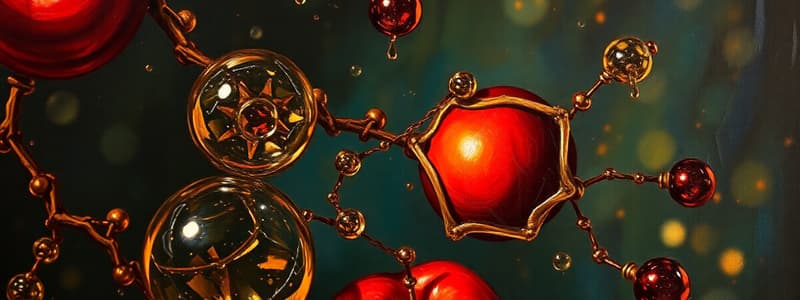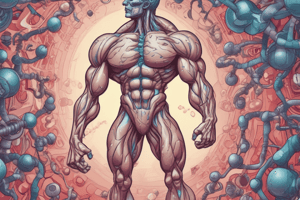Podcast
Questions and Answers
What is the structural basis for steroid hormones like estrogen and testosterone?
What is the structural basis for steroid hormones like estrogen and testosterone?
- Triglycerides
- Phospholipids
- Cholesterol (correct)
- Sphingomyelin
What is Niemann-Pick disease primarily caused by?
What is Niemann-Pick disease primarily caused by?
- Defective sphingomyelinase (correct)
- Increased phosphoglycerides
- Defective phospholipases
- Excess cholesterol production
Which component is not associated with the degradation of phospholipids?
Which component is not associated with the degradation of phospholipids?
- Sphingomyelin
- Phosphoglycerides
- Cholesterol (correct)
- Phospholipases
Which disease is commonly confused with Niemann-Pick disease?
Which disease is commonly confused with Niemann-Pick disease?
What characterizes cholesterol in biological membranes?
What characterizes cholesterol in biological membranes?
What is one of the main roles of lipids in the body?
What is one of the main roles of lipids in the body?
Which type of fatty acids are predominant in humans?
Which type of fatty acids are predominant in humans?
What is the structural feature of unsaturated fatty acids?
What is the structural feature of unsaturated fatty acids?
What is a significant characteristic of lipids concerning their solubility?
What is a significant characteristic of lipids concerning their solubility?
What role do fatty acids play in the liver?
What role do fatty acids play in the liver?
What component makes up the majority of dietary lipids in adults?
What component makes up the majority of dietary lipids in adults?
What characteristic of cis double bonds in fatty acids affects membrane fluidity?
What characteristic of cis double bonds in fatty acids affects membrane fluidity?
What are the fatty acids called that have a terminal carboxyl group?
What are the fatty acids called that have a terminal carboxyl group?
What role do triacylglycerols (TAGs) play in the body?
What role do triacylglycerols (TAGs) play in the body?
Which characteristics define phospholipids?
Which characteristics define phospholipids?
What is the primary role of sphingomyelin in humans?
What is the primary role of sphingomyelin in humans?
What is the defining feature of glycerophospholipids?
What is the defining feature of glycerophospholipids?
Which subclass of phospholipids is primarily associated with the inner mitochondrial membrane?
Which subclass of phospholipids is primarily associated with the inner mitochondrial membrane?
Which component is crucial in the formation of lung surfactant?
Which component is crucial in the formation of lung surfactant?
What is the structure of phosphatidic acid?
What is the structure of phosphatidic acid?
What type of lipids are isoprenoids derived from?
What type of lipids are isoprenoids derived from?
Flashcards
Cholesterol: What is it?
Cholesterol: What is it?
Cholesterol is a type of lipid (fat) that's essential for building cell membranes and making hormones. It's also a precursor to important steroid hormones.
Cholesterol: Where is it found?
Cholesterol: Where is it found?
Cholesterol is primarily found in the cell membranes, where it helps control membrane fluidity and permeability. It's also crucial for the synthesis of steroid hormones.
Steroid hormones: What are they?
Steroid hormones: What are they?
Steroid hormones are a class of hormones derived from cholesterol. They play a critical role in regulating various bodily functions, including development and reproduction.
Phospholipid Degradation: How does it happen?
Phospholipid Degradation: How does it happen?
Signup and view all the flashcards
Niemann-Pick disease: What is it?
Niemann-Pick disease: What is it?
Signup and view all the flashcards
What are lipids?
What are lipids?
Signup and view all the flashcards
Lipid Functions
Lipid Functions
Signup and view all the flashcards
Triacylglycerol (TAG)
Triacylglycerol (TAG)
Signup and view all the flashcards
Fatty Acids (FAs)
Fatty Acids (FAs)
Signup and view all the flashcards
Saturated vs. Unsaturated FA
Saturated vs. Unsaturated FA
Signup and view all the flashcards
Cis Double Bonds
Cis Double Bonds
Signup and view all the flashcards
FA Chain Length
FA Chain Length
Signup and view all the flashcards
Importance of FA Nomenclature
Importance of FA Nomenclature
Signup and view all the flashcards
Arachidonic Acid: -6 FA
Arachidonic Acid: -6 FA
Signup and view all the flashcards
Why is TAG a good energy storage form?
Why is TAG a good energy storage form?
Signup and view all the flashcards
Why not use carbohydrates for long-term energy storage?
Why not use carbohydrates for long-term energy storage?
Signup and view all the flashcards
Phospholipids: What are they?
Phospholipids: What are they?
Signup and view all the flashcards
Where are phospholipids found?
Where are phospholipids found?
Signup and view all the flashcards
Glycerophospholipids
Glycerophospholipids
Signup and view all the flashcards
Sphingophospholipids
Sphingophospholipids
Signup and view all the flashcards
Study Notes
Introduction to Lipids
- Lipids are a diverse group of water-insoluble organic molecules.
- Their insolubility in water leads to compartmentalization within the body.
- Membrane-associated lipids exist.
- Lipid droplets (TAGs) are found in adipocytes.
- Lipids are transported in plasma by lipoprotein particles.
Structural Relationship of Lipids
- Lipids are categorized into groups based on their structure.
- Simplest lipids include eicosanoids, which are derived from fatty acids (FAs).
- Other major lipid classes are illustrated.
- These categories include triacylglycerols, waxes, steroids, lipid vitamins, terpenes, isoprenoids, glycerophospholipids, sphingolipids, ceramides, sphingomyelins, and glycosphingolipids, among others.
- Phospholipids have a unique classification of subgroups.
Functions of Lipids
- Lipids are a major energy source.
- Lipids form hydrophobic barriers.
- Lipids include fat-soluble vitamins.
- Lipids have coenzyme functions.
- Lipids include hormones, such as steroids and prostaglandins.
- Lipids protect vital organs.
- Lipids act as carriers for vitamins and suppress hunger.
Dietary Lipids
- Adults typically ingest approximately 81 grams of lipids daily.
- A substantial portion (over 90%) is usually composed of triacylglycerols (TAGs).
- Other dietary lipids include cholesterol, cholesterol esters, phospholipids, and free fatty acids.
Common Lipids
- Diverse structural examples of important lipid molecules are included.
- Important examples of fatty acids, triacylglycerols, phospholipids, steroids, and glycolipids are illustrated.
- Illustrations show the hydrophobic portions of the molecules.
Fatty Acids
- Fatty acids are amphipathic molecules.
- They comprise a hydrophobic hydrocarbon tail and a terminal carboxyl group.
- The length of the hydrocarbon tail influences the molecule's hydrophobicity.
- Saturated fatty acids lack double bonds.
- Unsaturated fatty acids contain one or more double bonds, usually in the cis configuration.
- Cis bonds result in kinks in the fatty acid tails.
Fatty Acid Functions
- Fatty acids (FAs) can be oxidized by tissues, mainly liver and muscle, to produce energy.
- The liver uses fatty acids to produce ketone bodies.
- Fatty acids are structural components of membrane lipids (phospholipids and glycolipids).
- Fatty acids act as signaling molecules.
- Esterified FAs are the major energy reservoir in adipose tissue.
- FAs serve as the precursors for hormone-like prostaglandins.
Fatty Acid Saturation
- Saturated fatty acids lack double bonds.
- Unsaturated fatty acids contain one or more double bonds.
- Unsaturated fatty acids typically include cis double bonds.
- Cis double bonds create a kink in the fatty acid tail, affecting membrane fluidity.
- Changes in fatty acid composition alter membrane fluidity.
Fatty Acid Length and Position of Double Bonds
- Specific fatty acids like stearic, oleic, linoleic, and α-linolenic acids are detailed in terms of carbon number and degree of unsaturation.
- The structural formula examples reflect the cis configuration of double bonds.
Lipid Chain Length and Position
- Fatty acids with different chain lengths are important in the human body.
- In humans, fatty acids with 16, 18, and 20 carbons predominate.
- Fatty acids with more than 22 carbons are typically found in the brain.
- The attachment to the carboxyl group defines the α-carbon.
- The terminal methyl group defines the ω-carbon.
- Double bonds' position is denoted relative to the ω-end.
Triacylglycerols (TAGs)
- TAGs are complex lipids, composed of three fatty acids and one glycerol molecule.
- TAGs are the main form of stored energy in adipose tissue.
- TAGs are primarily stored as nearly anhydrous oily droplets in adipose tissue.
Phospholipids
- Phospholipids are polar, ionic compounds.
- They have an alcohol group attached to diacylglycerol or sphingosine.
- They have a hydrophilic head and a hydrophobic tail.
- They are amphipathic.
- Two major classes: glycerophospholipids and sphingophospholipids.
- Phospholipids are vital components of cell membranes.
Phospholipids (PLs) Location
- PLs are the predominant lipids in cell membranes.
- Phospholipids are also found in lung surfactant and bile.
Phospholipid Structure
- Two main types: glycerophospholipids and sphingophospholipids.
- Glycerophospholipids are based on glycerol backbone.
- Sphingophospholipids are based on the sphingosine backbone.
Glycerophospholipids
- Major phospholipids in membranes.
- Based on a phosphatidic acid backbone.
- Different structural variations create various subgroups.
- Examples include phosphatidylserine, phosphatidylcholine, phosphatidylethanolamine, and cardiolipin.
- Important in cell membranes and mitochondrial function.
Sphingophospholipids
- Sphingomyelin is the primary sphingophospholipid in humans.
- The backbone is sphingosine.
- They are an important component of myelin sheaths in nerve fibers.
- Sphingomyelin degradation plays a crucial role.
Isoprenoids
- Isoprenoids are lipids derived from isoprene.
- Cholesterol is an important example of an isoprenoid.
Cholesterol
- Present in biological membranes.
- Precursor for steroid hormones.
- Has amphipathic character.
Steroids
- All steroids share a common four-ring structure based on cholesterol.
- Examples include sex hormones (estrogen, progesterone, testosterone), and other hormones.
Metabolism of Lipids
- One aspect of lipid metabolism is phospholipid degradation.
- Phospholipases are enzymes that degrade phospholipids. Different types of phospholipases target different phospholipid bonds.
Niemann-Pick Disease
- A rare genetic disorder due to a defective sphingomyelinase enzyme.
- Sphingomyelin accumulates in cells.
- Affects the brain, spleen, and liver.
- Causes mental retardation and early death.
- Distinguished by the presence of foamy cells (accumulation in cells).
- A discussion of the inheritance pattern and the associated accumulation is included.
Tay-Sachs Disease
- Another genetic disorder affecting hexosaminidase A, responsible for degrading a specific ganglioside (GM2).
- This leads to a deficiency in GM2 ganglioside metabolism.
- Associated clinical symptoms.
Studying That Suits You
Use AI to generate personalized quizzes and flashcards to suit your learning preferences.




